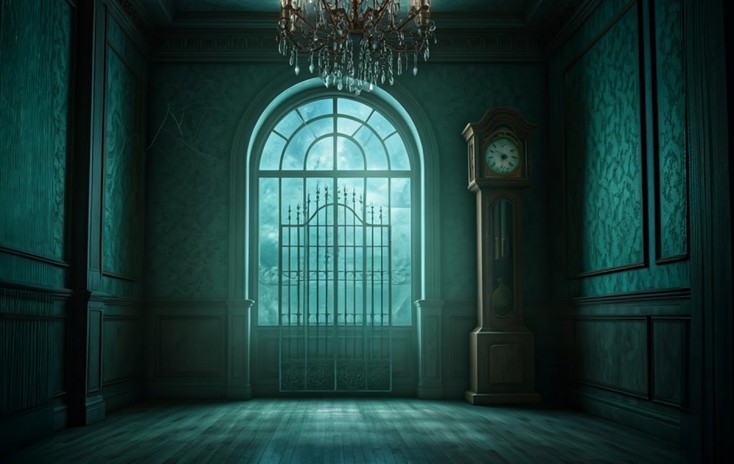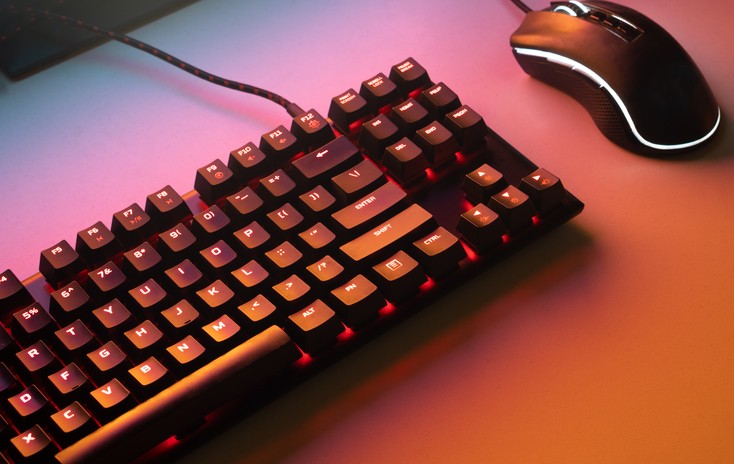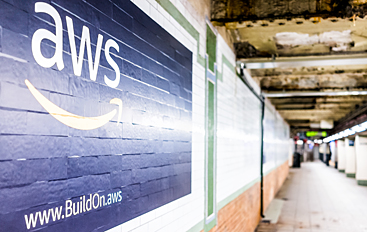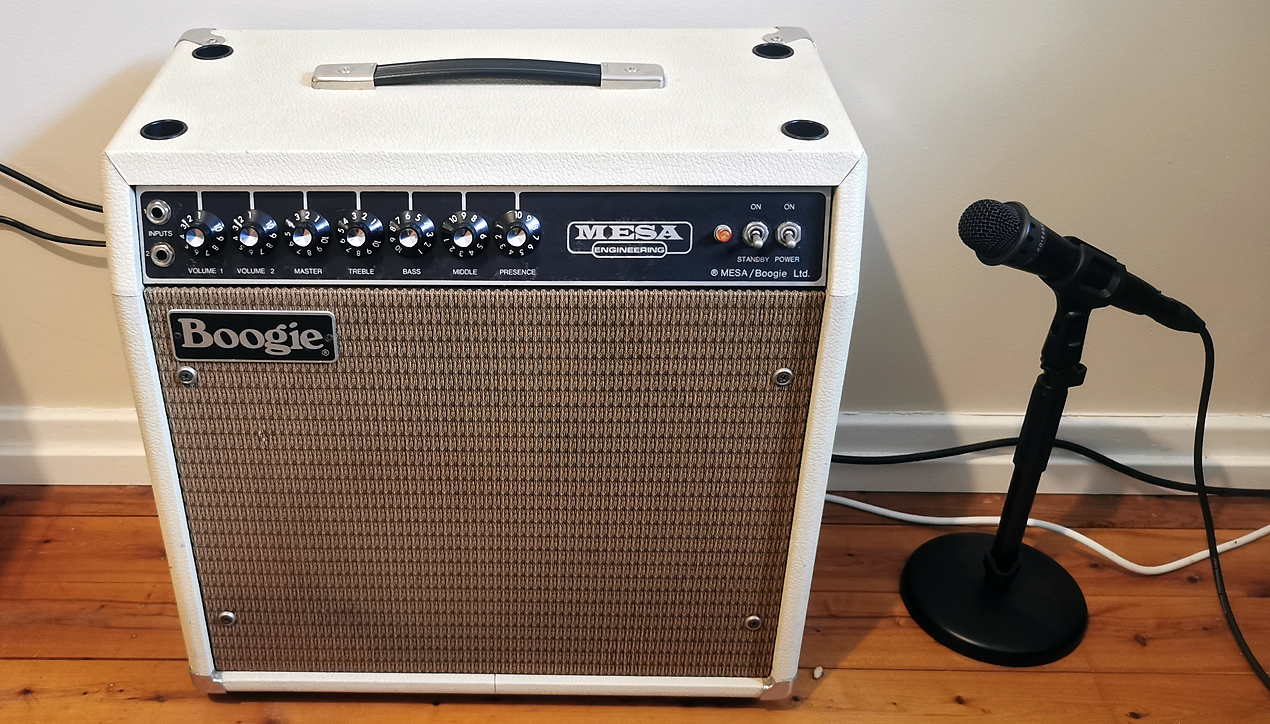
Massively Improve the Tone of a Mesa Boogie SOB Guitar Amp
This page describes an electronics "mod" which I did in 2015, and discovered that it can massively improve the tone of a Mesa Boogie SOB Vintage Guitar Amplifier.
SOB stands for "Son of Boogie", and was the first attempt by Mesa Boogie at a reissue of their famous Mark I amplifier. Which was used (and still is used) by many famous guitarists — both on stage, and to record albums with.
These SOB amplifiers (a.k.a. "amps") have a very mixed reputation. Many people say they sound absolutely awful, and some say they sound amazingly good.
When there's such a huge variation in opinion as this, sometimes it's not just a matter of differing personal tastes in terms of what people think sounds good — but there's a deeper underlying reason for the highly polarised opinions.
In this case, the reason turns out to be the fact that some of the SOB amps were sold with a "presence" tone control — and others did not have this control, which effectively meant the presence was "turned to 11" all the time — and this actually does sound truly awful if the amp is used for basically any kind of distorted guitar tone.
I also learned that for the SOBs sold with no presence control, (for someone who is familiar with electronics, as in soldering things, and working with tube/valve electronics), it is really quite easy to modify these amps to give them a presence control.
In summary:
- There's very wide disagreement about whether the SOB model of Mesa Boogie guitar amplifier sounds amazingly good, or utterly awful.
- Only some of the SOBs were made with a presence control, and these are the only ones that sound good with a distorted guitar tone (this is still true irrespective of whether you use the amp's internal distortion — or any kind of distortion pedal or effect unit and have the amp itself set to a clean tone).
- If you only ever play with a clean sound, the SOB can still sound good even with no actual presence control.
- Many of the SOBs which have a knob labelled "presence" on the front panel do not in fact have a presence control, but that knob is wired as a "limit" control.
- The limit control is basically useless.
- If you have a SOB like this, the mod to convert the fake presence control (that was factory-wired as a limit control though being labelled as a presence control) to a real actual presence control is extremely easy for someone with some electronics experience.
***WARNING*** Tube amps contain lethal voltages inside the chassis, and can do so even after the power has been disconnected, unless the filter capacitors in the PSU (Power Supply Unit) are discharged. The original post I made of this on the music electronics forum also contained this warning, which is repeated further down the page.
At least one person has died from working on a tube amp without doing this, although apparently this is a rare event. If you are considering really trying anything remotely like this mod, make sure that you know about this issue, and how to prevent it (e.g. by discharging the capacitors).
Electronics and Cybersecurity
Electronics skills like soldering used to play more of a role in Cybersecurity than they do now. For example, it was sometimes possible for a hacker to get free phone calls by connecting electronically modded devices to the phone network, and other things like that.
I'd imagine that even now there's probably still some role for electronics in hacking (and therefore also in defence against hacking), though much less than it used to be — and that now nearly everything is done through software. I'll have to look more into this...
MASSIVE improvement to Mesa Boogie SOB mod - How to add a real presence control
The rest of this page was originally a post made at 09-02-2015, 12:56 PM on music-electronics-forum.com. Some of it has been edited for this version on Codewiz.au. I'll probably edit it some more in future so that it reads better, and makes more sense for readers not used to reading about music-related electronic projects.
When I first thought of the idea to add this page to Codewiz.au, I was wondering how long it would take me to locate / track down my original forum post about it, so I could add it to this website. All I ended up having to do was type mesa boogie sob mod presence into Google, and it was the first search result.
Original Post
09-02-2015, 12:56 PM: I modded my Mesa Boogie SOB to have a real presence control, and the improvement in tone was out of this world. Especially for distorted tone but also (though less dramatic) for cleans. IMO the old boogies really need a presence control.
The presence is different from the other tone controls, since it doesn't just shape the tone in the middle of the preamp section, rather it adds negative feedback from the output of the output transformer (i.e. the speaker terminal) to the front/input of the phase inverter, with a capacitor, having the effect of controlling the really high trebles.
The SOB has been regarded historically as less desirable (probably the least desirable) out of of the vintage Boogies. It comes with a "limit" control, which is meant (especially according to the original advertising of these amps) to allow power amp-like distortion at bedroom volume levels, but according to basically everyone sounds totally crap and is best left in the 0 position (having no effect).
Turning the limit knob up starves the PI (phase inverter) of power, causing it to clip (i.e. distort) at lower volumes than otherwise. One forum post I saw said it should be labelled a "suck" control. The few people who said the control was useful said it should only ever be used in small amounts, at settings from 0 to 1 or maybe 2 out of 10.
More recent posts about the SOBs in general are more favourable, especially with regard to the clean tone.
The long head versions of the SOB's come with both a presence and a limit.
The other SOBs have either one or the other, and, don't be fooled, the label on the front panel is no indication of what you have, in terms of how your amp is actually wired, since many of the SOBs (possibly most of them apart from the long heads) that say "presence" on the front panel under the knob are actually not really wired with a presence control at all — but the knob is internally wired as a limit control.
If you didn't know the above fact, and even if you had already heard that only the SOB models with a presence control sound any good — and then you bought one like that, and (quite rationally) thought that the label of "presence" on the front panel of your amp meant that it actually did have a presence control — and found the tone of the amp to be awful, you would probably conclude that "the SOB model does sound awful like so many people say".
The happy news is to mod these amps back to having a real presence control is ridiculously easy (assuming you have some experience working with tube amps).
***WARNING*** tube amps contain lethal voltages inside the chassis, and can do so even after the power has been disconnected, unless the filter capacitors in the PSU are discharged. (Is is necessary to say this warning on a forum specifically about music electronics? Or is it assumed people will know this)?
My SOB says presence on the front, but it was really a limit, but someone had modded it (presumably to make it sound less crap) by adding a resistor and capacitor across the pot (a.k.a. potentiometer, a.k.a. variable resistor, i.e. the internal part behind the control knobs on the amp).
Their limit-control mod didn't seem to do that much at all, other than change the volume slightly. Perhaps they thought that mod was worth a try in the hope that it might make the amp sound better, and then they realised it didn't have much effect, and then they sold the amp, lol.
I looked at the schematics for the SOB and found two versions, and I could see how the presence was meant to be wired. The nice thing was that the capacitor needed for it was already there on the PCB, with one end attached to nothing. [Evidently not all of the SOBs already have the capacitor on the board, see the bottom of this page. I must have been lucky.]
All that was needed for the mod was to remove the limit pot, and wire the other end of the TCR current limiting diode (that looks like a 2 legged transistor) that was connected to the pot to ground, to remove the limit completely (so its like its set on 0 permanently). If you wanted, an additional pot could be added to have both but I didn't think the limit was worth bothering with.
Then, add a new pot of the right value (I'll post later with the actual values and a pic, I think its 250K [and YES it is Audio taper]) , and wire the wiper (i.e. middle lug) of the pot to the free end of the capacitor on the PCB (right next to where the pot is), and the side of the pot closest to the power switches (with the pot lugs facing up like all the other pots) is wired to the 8 ohm speaker output with a long wire that goes all the way from the pots at the front to the speaker jack at the back. That's it.
The improvement in tone was amazing. With the distortion, there was previously a harsh fizz that couldn't be removed by any of the other tone controls. The original configuration was equivalent to having the presence turned to 10 all the time (actually perhaps to 11 if you consider the 250K of the pot is still in the circuit when its on 10, and originally it would have been infinite resistance). With clean sounds, higher values of the presence can be used and give the amp some "vintage sparkle", but with distortion I find lower values of at most 6, or 5 or 4 are much much nicer sounding and smoother. This applies to both the internal distortion and to using pedals for distortion.
I've got a studio .22 and I find the presence control on that (which is a similar style of operation) to be extremely useful. I think its more useful than the graphic, unless you want a really scooped sound for metal, the graphic isn't absolutely necessary IMO but the presence control is what makes the amp as it has such a powerful effect on the tone.
I haven't heard a Mark I but I'd go as far as to suggest that having a presence control would probably be the majority of the difference in sound between the Mark I and the SOB.
[Later addition, I did jam with a friend who has a real Mark I, and we both agreed the distortion tone on my SOB (this was after I'd done the mod) was deeper and better sounding than that of the original Mesa Boogie Mark I. I can't remember for sure, but the original Mark I may have had a slightly better clean tone, maybe.]
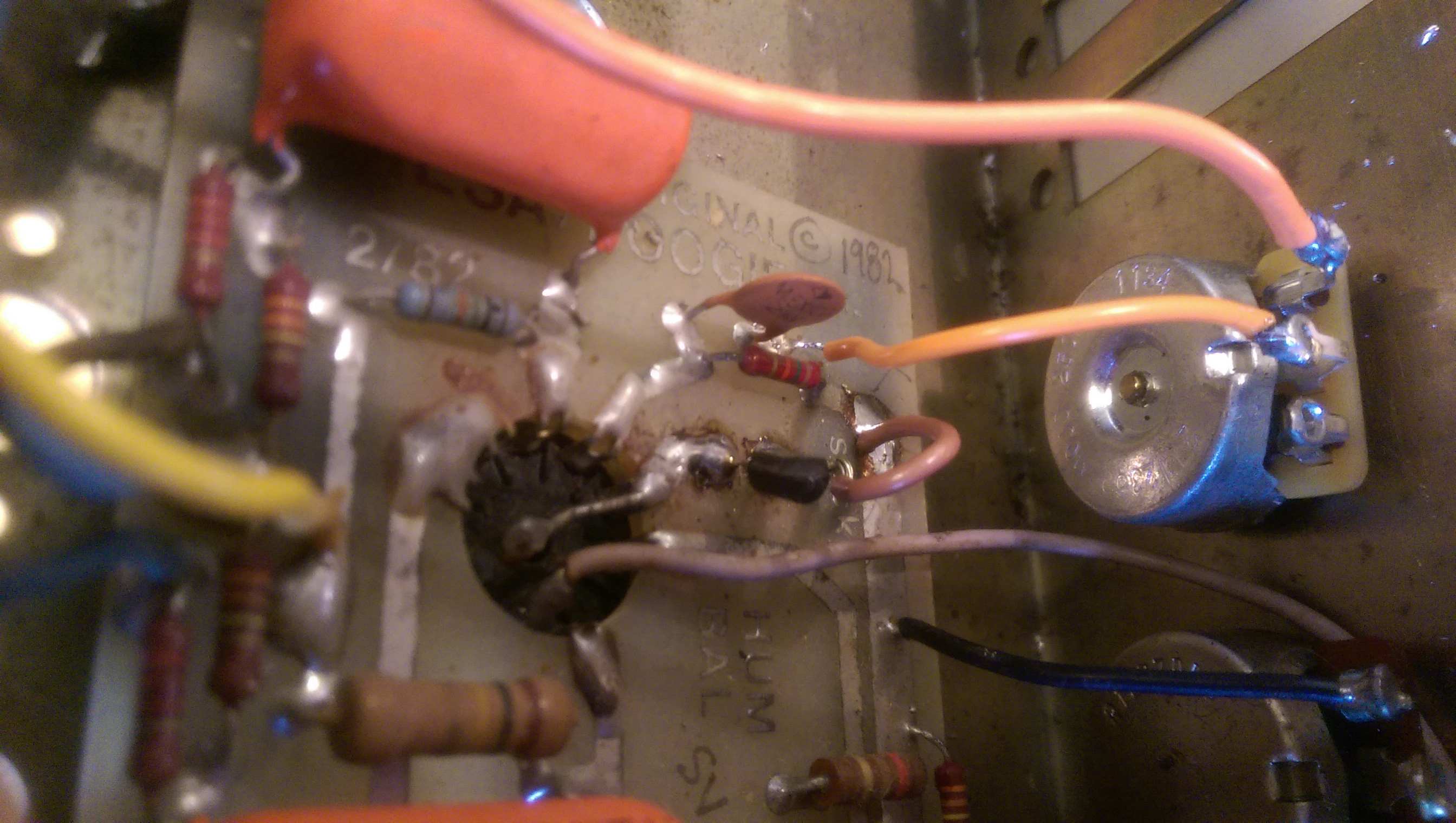
The completed mod for adding a presence control to a Mesa Boogie SOB. It was just replacing the pot, and adding 3 wires: Two of them on the new pot, plus the tiny brown loop/jumper wire on the circuit board.
09-02-2015, 03:06 PM: Note that on this PCB the components and the solder joints are both on the same (top) side of the board, so nothing needs to be disassembled.
The pot is 250K, I can't remember if log/audio or linear taper, I'll have to look in the amp next time I open it. At a guess I would say audio taper [YES it is audio taper]. Whichever it is, its a nice taper as the range is very usable. It's a different value pot to the limit pot so you do need to change the pot itself to perform the mod. The limit pot on the schematic is 1M so i guess if you left it, it would still work but the taper would be much less ideal. (Meaning the usable range of the knob would be a small part of its possible turning positions).
The light orange wire is soldered from the wiper of the pot to the previously unconnected end of the ceramic disc capacitor.
The darker orange wire goes from the upper (with respect to the orientation on image above) wiring terminal of the pot to the hot of the 8 ohm speaker jack (the next photo will show both ends of it).
I thought about using shielded wire but then figured that its being connected to the speaker terminal, and the speaker wire isn't shielded nor is the wire from the output transformer, so it should be ok. There was no noticeable increase in noise after adding it. The SOB is a beautifully quiet amp overall in terms of unwanted noise/hiss — unlike the Studio .22 which is really pretty noisy (and makes one wonder about the use of them in a real "studio", though I have used a Studio .22 to record in an actual recording studio, and it was fine). The high voltage wires supplying the power tubes/valves (which the newly added dark orange wire is cable-tied next to) are DC and not AC, which means they shouldn't be emitting 50 Hz interference like an AC power wire would).
The small brown wire/jumper goes from the end of the TCR diode (that looks like a transistor) to the ground strip on the PCB. This connection from the TCR was previously connected to the limit pot.
That's pretty much it.
I added some cable ties (as seen in the image below, they are the three yellow ones on the long dark-orange wire from the new pot to the speaker output) to tidy it up. The other cable ties (the white ones) were there originally. The presence is the rightmost knob.
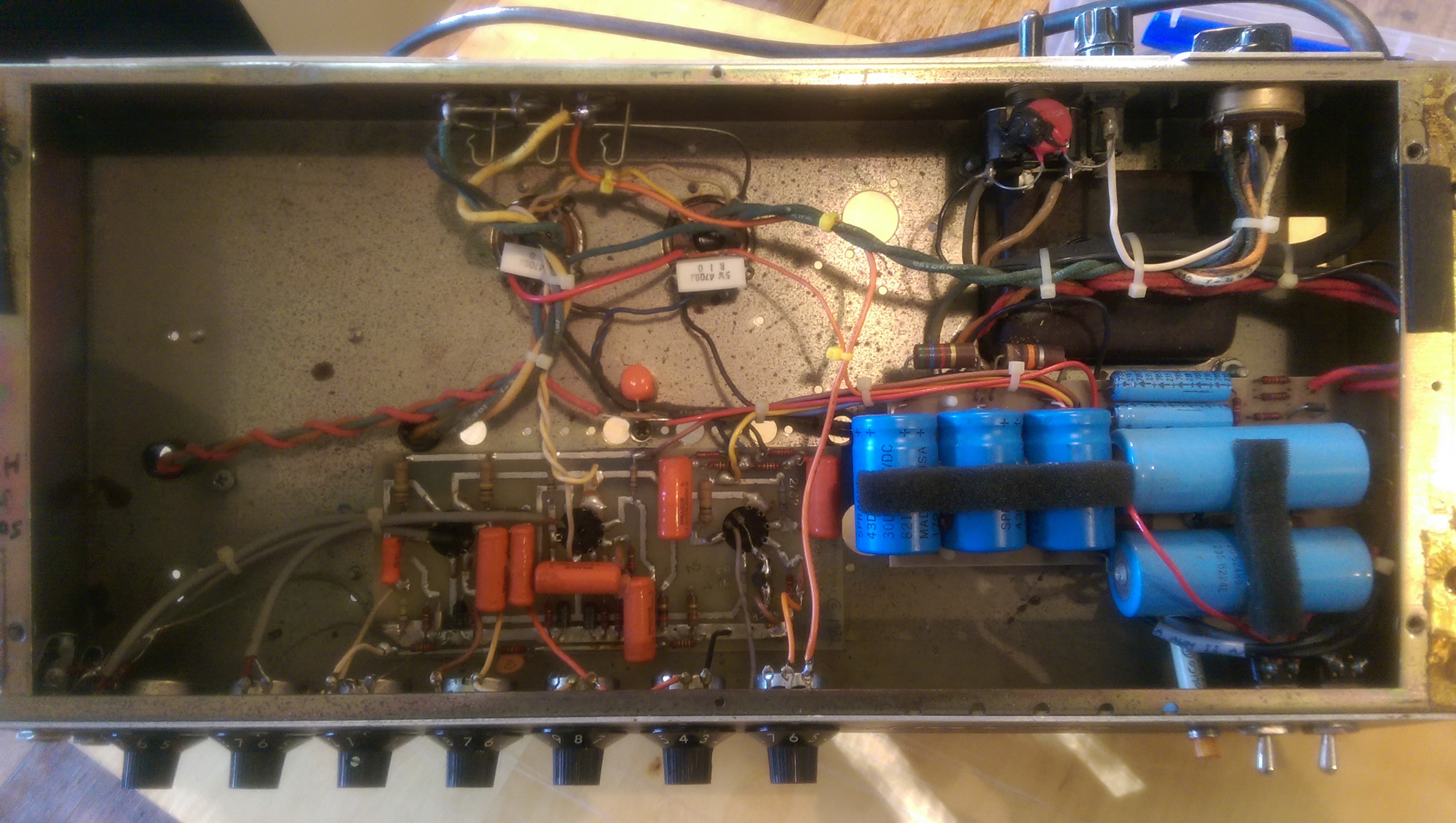
In this pic you can see the whole internals of the amp, and where the other end of the added dark orange wire should be soldered to (see description above).
In the pic above you can see the new pot on the rightmost side of the line of them, on the inside of the amp, right behind the knobs on the front panel. It's the one with the most shiny silver case — because it was brand new when I put it in, and not made in 1982 like the rest of the amp.
At the end of the original version of this post, there's a couple of extra comments:
09-08-2015, 10:02 AM: The presence pot is 250K Audio taper.
When I "Googled" to find this page, so I could add it to Codewiz.au, I noticed another reader has asked a question, as below. I'll have to try to find my login details for that forum and reply to it now. I must have used an email address for the forum account which I no longer use now (most probably an email address with a domain from when I had a guitar teaching business).
09-29-2020, 10:12 PM: Hi...you mentioned. "The light orange wire is soldered from the wiper of the pot to the previously unconnected end of the ceramic disc capacitor." I do not have this on my PCB. What is the ceramic disc cap value you have on yours?
Thanks!
The Mesa Boogie Studio .22
Incidentally the Mesa Booogie Studio .22 amp model beats the SOB (even with this mod) and anything else I own for distorted guitar sound.
Depending on opinion, they may even have the best distorted guitar tone of any amp made. For example, nearly all of Nirvana's most famous album "Nevermind" was recorded with one — and, presumably, at that first-tier level of record-company-contracts and heights of stardom, and recording engineering tech, they would have been able to afford and have available basically any amp or guitar sound possible at the time.
The Studio .22 really is a great amp for distortion, if you can find one now.
Another really good thing about them is that it's possible to mod the USA 120-volt models to run from Australian 240 mains voltage really very easily (about as easy as the SOB mod on this page). I may describe that mod in a future web page.
Usually doing a mod to change the main voltage an amp runs from (if it isn't already made to work with selectable "international" mains voltages) means you need to add a completely new power transformer. And this is the case on nearly all the Mesa Boogie amp models (apart from the ones sold as international selectable-voltage, which generally sell for more money).
However the Studio .22, very conveniently, already has a power transformer with alternate wiring possibilities for different/international voltages (like 240 volts as we have in Australia). It just doesn't have a switch on the back of the amp, which would allow you to choose which of the windings get connected, like the "international" models do.
I'm not sure if all the Studio .22 models already have this type of power transformer (rather than the more usual single-voltage-only type), however on the schematic diagram of the Studio .22 from Mesa Boogie, the extra transformer winding is there, and it was there on my real physical amp too when I opened it up to look inside.
And the Studio .22 mod works beautifully, so I can plug in my previously-120-volt Studio .22, bought on eBay from the USA, directly into the Australian 240-volt mains now.
Security Note
Note to potential burglars reading this page: Perhaps, in future, I'll even live in a place big enough that I don't have to keep most of my gear (including nearly all my guitar gear) at a storage unit far away from where I live.
Stuxnet and the Birth of Cyber War
Most people are aware of the horrors of nuclear war. However there is much less awareness of the civilisation-ending potential of cyber war. Stuxnet is one of the most famous and sophisticated pieces of malware...
Byte.Yoga – A New Name for this Blog
Exciting News: Codewiz.au is Now Byte.yoga! Dear Readers, We're thrilled to announce a significant update that marks a new chapter for our blog. As part of our ongoing evolution and commitment to bringing you the best...
This page describes setting up a CFML server using Lucee (compatible with Adobe ColdFusion CFML pages) on Amazon's AWS EC2 cloud computing service. I was looking for a way to host example/demo versions of some of...

 Welcome to Byte Yoga, my blog about Coding, Computers and IT.
Welcome to Byte Yoga, my blog about Coding, Computers and IT.
 Spysafe.com.au and Codewiz.au have become Byte Yoga!
Spysafe.com.au and Codewiz.au have become Byte Yoga!
 View My Programmer and Full Stack Developer Portfolio.
View My Programmer and Full Stack Developer Portfolio.
 About Byte Yoga – IT, Coding, tech, security, careers, and stuff.
About Byte Yoga – IT, Coding, tech, security, careers, and stuff.



